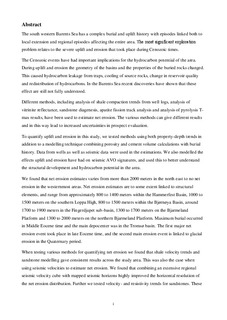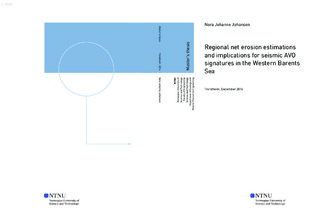| dc.description.abstract | The south western Barents Sea has a complex burial and uplift history with episodes linked both to local extension and regional episodes affecting the entire area. The most significant exploration problem relates to the severe uplift and erosion that took place during Cenozoic times.
The Cenozoic events have had important implications for the hydrocarbon potential of the area. During uplift and erosion the geometry of the basins and the properties of the buried rocks changed. This caused hydrocarbon leakage from traps, cooling of source rocks, change in reservoir quality and redistribution of hydrocarbons. In the Barents Sea recent discoveries have shown that these effect are still not fully understood.
Different methods, including analysis of shale compaction trends from well logs, analysis of vitrinite reflectance, sandstone diagenesis, apatite fission track analysis and analysis of pyrolysis T-max results, have been used to estimate net erosion. The various methods can give different results and in this way lead to increased uncertainties in prospect evaluation.
To quantify uplift and erosion in this study, we tested methods using both property-depth trends in addition to a modelling technique combining porosity and cement volume calculations with burial history. Data from wells as well as seismic data were used in the estimations. We also modelled the effects uplift and erosion have had on seismic AVO signatures, and used this to better understand the structural development and hydrocarbon potential in the area.
We found that net erosion estimates varies from more than 2000 meters in the north east to no net erosion in the westernmost areas. Net erosion estimates are to some extent linked to structural elements, and range from approximately 800 to 1400 meters within the Hammerfest Basin, 1000 to 1500 meters on the southern Loppa High, 800 to 1500 meters within the Bjørnøya Basin, around 1700 to 1900 meters in the Fingerdjupet sub-basin, 1300 to 1700 meters on the Bjarmeland Platform and 1300 to 2000 meters on the northern Bjarmeland Platform. Maximum burial occurred in Middle Eocene time and the main depocenter was in the Tromsø basin. The first major net erosion event took place in late Eocene time, and the second main erosion event is linked to glacial erosion in the Quaternary period.
When testing various methods for quantifying net erosion we found that shale velocity trends and sandstone modelling gave consistent results across the study area. This was also the case when using seismic velocities to estimate net erosion. We found that combining an extensive regional seismic velocity cube with mapped seismic horizons highly improved the horizontal resolution of the net erosion distribution. Further we tested velocity- and resistivity trends for sandstones. These net erosion estimates varied too much and are probably not reliable. Generally we saw that combining and cross testing methods increased reliability in the net erosion estimations.
Relatively small changes in reference trends could produce significantly different net erosion estimates, and since there are few good reference wells in the Barents, the North Sea was used as reference area. We established references trends for shale velocity, shale resistivity, sandstone velocity, sandstone resistivity and smectite-illite rich shales. Before they were used for estimating net erosion, the North Sea trends were compared to single wells in an area with no uplift in the Barents Sea.
Testing resistivity trends for shales showed geographical variations as for the other methods, but these net erosion estimates were unrealistically high. We interpret this to be caused mainly by cooling due to uplift of the formations. The effect of cooling can be estimated by combining velocity trends and resistivity trends. This work flow can potentially also be used to estimate the temperature gradient for the actual area.
When including net erosion estimates in modelling of seismic AVO signatures for the Stø reservoir formation, we found that AVO signatures are strongly influenced by the amount of net erosion. The AVO modelling demonstrated that both the fluid content in the reservoirs and the maximum burial depth have strong influence on which AVO class the responses belong to. The modelled AVO signatures were compared to real AVO responses at the south western margin of the Loppa High. Here the real AVO responses were calibrated to wells, and the modelled results gave good match with the real responses. | |

